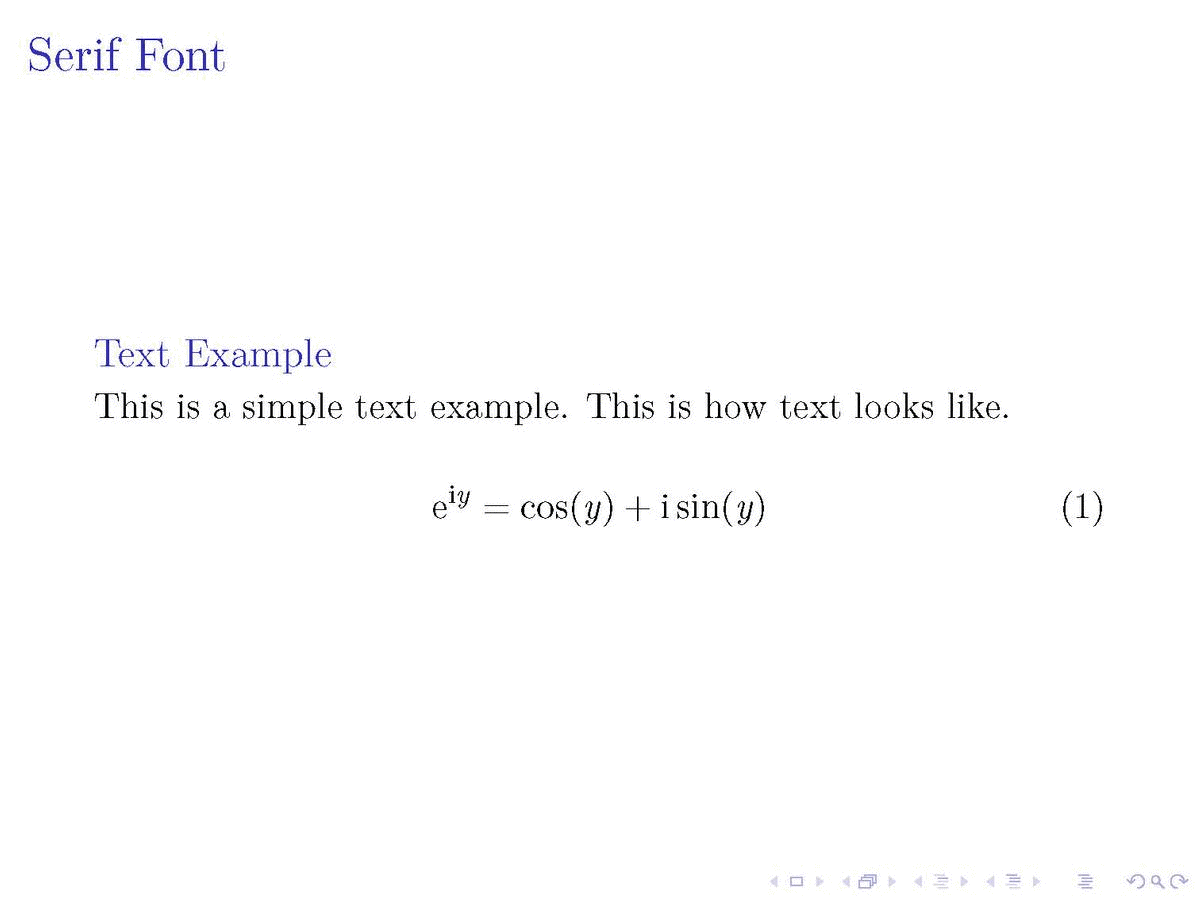
使用 LaTeX 写作我知道在表格中使用垂直线是糟糕的排版。
幻灯片是否有适合/不适合的排版方式,以便新手可以理解?
您可以提供一些关于此问题的知名文档。
答案1
- 我确实区分了排版建议和演示文稿的一般建议(例如,不要从幻灯片中读取,使用图像等等)。
- 我理解这种情况下排版的程度非常狭窄(例如选择哪种字体)。
- 我推荐和其他人(例如米科, 看这里)使用宽而暗的无衬线字体。
- 如果您使用衬线字体,那么对于演示设备的有限分辨率而言,衬线有时会太细(与纸上打印相比)。
- 此外,我认为无衬线字体通常更容易在屏幕上阅读。据我所知,大多数操作系统都使用无衬线字体。
- 我举了三个小例子来阐明我的观点:)。
- 此外,我认为所谓的大的 x 高度这对于提高可读性也大有裨益。(在活动挂图上书写时也是如此。)
\documentclass{beamer}
%% 1. Serif Font
\usefonttheme{serif}
%%% 2. Normal Sans Serif Font
%\usepackage{newtxsf}
%%% 3. Wide and Dark Sans Serif Font
%\usefonttheme{professionalfonts}
%\usepackage{arev}
\begin{document}
% ---
\begin{frame}
\frametitle{Serif Font}
%
\begin{block}{Text Example}
This is a simple text example. This is how text looks like.
\end{block}
%
\begin{equation}
\text{e}^{\text{i}y} = \cos(y) + \text{i} \sin(y)
\end{equation}
%
\end{frame}
% ---
% ---
\begin{frame}
\frametitle{Normal Sans Serif Font}
%
\begin{block}{Text Example}
This is a simple text example. This is how text looks like.
\end{block}
%
\begin{equation}
\text{e}^{\text{i}y} = \cos(y) + \text{i} \sin(y)
\end{equation}
%
\end{frame}
% ---
% ---
\begin{frame}
\frametitle{Wide and Dark Sans Serif Font}
%
\begin{block}{Text Example}
This is a simple text example. This is how text looks like.
\end{block}
%
\begin{equation}
\text{e}^{\text{i}y} = \cos(y) + \text{i} \sin(y)
\end{equation}
%
\end{frame}
% ---
\end{document}
对评论的反应
不太知名但也许是获得 Google 搜索正确搜索词的开始:)。
以前在线排版的可用性指导原则很简单:坚持使用无衬线字体。由于计算机屏幕太差,无法正确呈现衬线字体,因此在正文大小下尝试衬线字体会导致字母形状模糊。[...] 1996 年,微软著名的排版小组推出了 Verdana,这是首批专门为提高屏幕文本可读性而设计的字体之一。(成立这里。)



